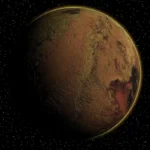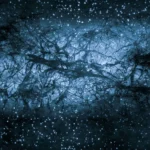
At the North and South Magnetic Poles of our planet Earth, we see the sky light up, flash and shimmer. We call this effect an aurora. In the northern hemisphere it is called the Aurora borealis, also known as the “Northern Lights”. In the southern hemisphere, it is called Aurora australis, also known as the “Southern Lights”.
The International Space Station sits at the same altitude as the Northern Lights meaning astronauts can see the lights from the side.
Particles too small to see with our eyes, called plasma, stream away from the Sun travelling at 1,000,000 mph (1,609,344 km/hr). This stream of particles is called the Solar Wind.
There are also the Southern Lights which offer a similar visual display.However due to their location over places with not much land mass, such as South Georgia island, New Zealand and the Falkland Islands, they are not as popular.
Plasma is made up of mainly electrons with some protons.
People have been observing the Northern Lights as far back as 1619 and they’ve had many stories linked to them.
The Solar wind takes 40 hours to reach our plant’s atmosphere because the Earth is 92,960,000 miles (149,600,00 km) away from the Sun.
No two light displays are the same, the colour and patterns always differing.
The Solar wind comes into contact with the gases in the Earth’s atmosphere and the Earth’s magnetic field. This causes the gases in our atmosphere to light up and this is what we call an aurora.
A pale yellow-green is the most common colour followed by pink and a mix of red and green.
The aurora light can be a different color, depending on the type of gas the plasma mixes with and the height above the Earth’s surface.
Witnessing pure blue light is very rare as well as pure red which is produced by high-altitude oxygen found at heights of up to 200 miles above the earth.
Nitrogen in the air 60 miles above the planet’s surface reacts with the plasma in the solar wind and turns the sky blue.
Scandinavia is one of the most popular areas for Northern Light viewing however they are also seen in Canada, Scotland, Russia and Alaska.
Nitrogen in the air more than 60 miles (96.5 km) above the planet’s surface reacts with the plasma and turns the sky purple.
Other planets also have their own auroras. Astronomers have witnessed the lights on Saturn, Uranus, Neptune and Jupiter.
Oxygen in the air from 60 miles (96.5 km) up to 150 miles (241 km) above the planet’s surface reacts with the plasma in the solar wind and turns the sky green.
The auroras are relatively dim to the naked eye and human retinas can limit certain colours, so watching through a long-exposure camera setting will provide a higher chance of a better sighting.
Oxygen more than 150 miles (241 km) above the planet’s surface reacts with the plasma in the solar wind and turns the sky red.
Not everyone associated the lights with gods or postivity. In fact, in the British Isles the skies were said to have ‘blazed red’ just a few weeks before the French Revolution.
The aurora tends to disappear at heights of 120 to 200 miles (200 to 300 km) above the Earth’s surface.
The aurora look like moving ribbons of light because the particles of plasma are moving in response to the Earth’s magnetic field.
In Italy and France the lights were believed to be a bad omen that could herald the outbreak of anything from war to plague.
The plasma forming the aurora move as an electric current in the air, flowing at 20,000,000 Amps with a voltage of 50,000 volts.
In Japanese culture for example, a child conceived during a northern lights display will be blessed with good looks, intellect and good fortune.
The best place to see the Aurora borealis is Alaska, USA in the winter months when it is constantly (24 hours) of darkness.
An aurora display is actually a distortion in the earth’s magnetic field.
In Europe one of the best places to see the Aurora borealis is Tromso, Norway and the city of Murmansk on the Kola Peninsula of Russia.
The northern lights are only visible when it’s dark, but they can occur at any time.
The best place to see the Aurora australis is in Antarctica in the winter months. If the Aurora australis is strong, then it can be seen in Tasmania, Australia and Stewart Island off the southern coast of New Zealand.
Experts believe that 500 years ago, the auroral oval was probably located over southern Norway.
When solar storms erupt on the surface of the Sun, the aurora is very strong and extends further away from the Earth’s poles.
In 1939, Norwegian physicist Lars Vegard proved hydrogen emissions in aurora borealis. Nine years later, he pointed out the doppler effect in hydrogen lines of aurora borealis.
In 1989, the Aurora borealis could be seen as far south as Florida, USA and the island of Cuba.
Norwegian mathematician and astrophysicist Carl Størmer (1874–1957) studied the movement of charged particles in the magnetosphere.
The aurora can also be closer to the Earth’s surface at 50 miles (80 km) at times of intense solar activity.
It was German physicist and astronomer Otto Rudolf Martin Brendel (1862–1939) who took the first known photograph of the aurora borealis.
The solar wind can disrupt our radio, television and satellite communications.
Taken on 5 January, 1892, the black-and-white photo of the aurora borealis was published in ‘The Century’ magazine in October 1897.
Astronauts on duty in the International Space Station orbiting our planet at an altitude of 230 miles (370 km) above the Earth are level with the Aurora borealis.
Norway has a church inspired by the northern lights known as the northern lights cathedral.
The Aurora borealis was named by the Italian scientist Galileo Galilei from the Roman word for “Goddess of the Dawn” which is “Aurora” and from the Greek word used to describe a “wind of the north” which is “Boreas”.









